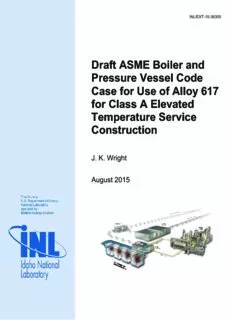Table Of Content(cid:3)
(cid:3)
(cid:44)(cid:49)(cid:47)(cid:18)(cid:40)(cid:59)(cid:55)(cid:16)(cid:20)(cid:24)(cid:16)(cid:22)(cid:25)(cid:22)(cid:19)(cid:24)
(cid:39)(cid:85)(cid:68)(cid:73)(cid:87)(cid:3)(cid:36)(cid:54)(cid:48)(cid:40)(cid:3)(cid:37)(cid:82)(cid:76)(cid:79)(cid:72)(cid:85)(cid:3)(cid:68)(cid:81)(cid:71)(cid:3)
(cid:51)(cid:85)(cid:72)(cid:86)(cid:86)(cid:88)(cid:85)(cid:72)(cid:3)(cid:57)(cid:72)(cid:86)(cid:86)(cid:72)(cid:79)(cid:3)(cid:38)(cid:82)(cid:71)(cid:72)(cid:3)
(cid:38)(cid:68)(cid:86)(cid:72)(cid:3)(cid:73)(cid:82)(cid:85)(cid:3)(cid:56)(cid:86)(cid:72)(cid:3)(cid:82)(cid:73)(cid:3)(cid:36)(cid:79)(cid:79)(cid:82)(cid:92)(cid:3)(cid:25)(cid:20)(cid:26)(cid:3)
(cid:73)(cid:82)(cid:85)(cid:3)(cid:38)(cid:79)(cid:68)(cid:86)(cid:86)(cid:3)(cid:36)(cid:3)(cid:40)(cid:79)(cid:72)(cid:89)(cid:68)(cid:87)(cid:72)(cid:71)(cid:3)
(cid:55)(cid:72)(cid:80)(cid:83)(cid:72)(cid:85)(cid:68)(cid:87)(cid:88)(cid:85)(cid:72)(cid:3)(cid:54)(cid:72)(cid:85)(cid:89)(cid:76)(cid:70)(cid:72)(cid:3)
(cid:38)(cid:82)(cid:81)(cid:86)(cid:87)(cid:85)(cid:88)(cid:70)(cid:87)(cid:76)(cid:82)(cid:81)(cid:3)
(cid:3)
(cid:45)(cid:17)(cid:3)(cid:46)(cid:17)(cid:3)(cid:58)(cid:85)(cid:76)(cid:74)(cid:75)(cid:87)(cid:3)
(cid:36)(cid:88)(cid:74)(cid:88)(cid:86)(cid:87)(cid:3)(cid:21)(cid:19)(cid:20)(cid:24)(cid:3)
(cid:3)
(cid:3)
DISCLAIMER
This information was prepared as an account of work sponsored by an
agency of the U.S. Government. Neither the U.S. Government nor any
agency thereof, nor any of their employees, makes any warranty, expressed
or implied, or assumes any legal liability or responsibility for the accuracy,
completeness, or usefulness, of any information, apparatus, product, or
process disclosed, or represents that its use would not infringe privately
owned rights. References herein to any specific commercial product,
process, or service by trade name, trade mark, manufacturer, or otherwise,
does not necessarily constitute or imply its endorsement, recommendation,
or favoring by the U.S. Government or any agency thereof. The views and
opinions of authors expressed herein do not necessarily state or reflect
those of the U.S. Government or any agency thereof.
INL/EXT-15-36305
Draft ASME Boiler and Pressure Vessel Code Case for
Use of Alloy 617 for Class A Elevated Temperature
Service Construction
J. K. Wright
August 2015
Idaho National Laboratory
INL ART Program
Idaho Falls, Idaho 83415
http://www.inl.gov
Prepared for the
U.S. Department of Energy
Office of Nuclear Energy
Under DOE Idaho Operations Office
Contract DE-AC07-05ID14517
ABSTRACT
The American Society of Mechanical Engineers (ASME) Boiler and Pressure
Vessel Code currently only allows five materials for use in construction of
nuclear components for high temperature service. These are: 2.25Cr- 1Mo and V
modified 9Cr-1Mo steels, Types 304 and 316 stainless steels and the high nickel
Alloy 800H. Since 2005, the US high temperature gas-cooled reactor program
has been characterizing elevated temperature mechanical properties of Alloy 617
as the leading candidate material for the intermediate heat exchanger. After
analysis of these experimental results, along with historical data and additional
results available through the Generation IV International Forum Very High
Temperature Reactor Materials Program Management Board Materials
Handbook, a draft ASME Code Case to allow nuclear construction with Alloy
617 has been developed.
This report contains the draft of a Section III, Division 5, Section HB,
Subsection B, Code Case for Alloy 617 to qualify it for use in construction of
nuclear components up to 1750°F (950°C) for service life up to 100,000 hours.
The draft contained in Appendix 1, subject to editorial revision and approval by
the ASME Special Task Group on Alloy 617 Code Qualification, will be
submitted for approval by letter ballot by the appropriate ASME Committees.
The technical justification supporting the Code Case is presented in Appendix 2
of this report. This background document is part of the information package that
will be submitted with the Code Case for ballot.
vii
viii
ACKNOWLEDGEMENTS
The author gratefully acknowledges the contributions of Sam Sham at ORNL
for planning, testing and analysis of the data that support the draft Code Case.
The ASME Special Task Group on Alloy 617 Code Qualification made
substantial contributions to defining the process for obtaining Code allowable
stresses; active participants include, Michael Swindeman, Peter Carter, Tai
Asayama, Jim Nestell, Mainak Sengupta, and Weiju Ren, and in particular the
contributions of Bob Swindeman and Keith Morton. Bob Jetter developed the
detailed template for the Code Case and made innumerable suggestions for how
the authors should approach determination of many of the stress allowable
values. His deep historical understanding of the high temperature design methods
played a key role in guiding the special Task Group.
At INL, Laura Carroll directed the fatigue and creep-fatigue testing and
analysis that were carried out in the laboratory by Joel Simpson, Randy Lloyd,
Julian Benz and Tim Yoder. Mark Carroll, Todd Morris and Tammy Trowbridge
conducted important microstructural analysis on deformation mechanisms that
support the background to the Code Case. Tom Lillo was critical to creep testing
and tertiary creep analysis. The authors are particularly grateful to Nancy Lybeck
for her efficient, careful and responsive support of the statistical data analysis and
archiving, and taking on the complex task of developing methods to generate hot
tensile and isochronous stress strain curves. Finally, the leadership of Richard
Wright has been critical to the success of the high temperature materials program
and the development of an Alloy 617 ASME draft Code Case.
ix
x
Description:Handbook, a draft ASME Code Case to allow nuclear construction with Alloy the ASME Special Task Group on Alloy 617 Code Qualification, will be.

